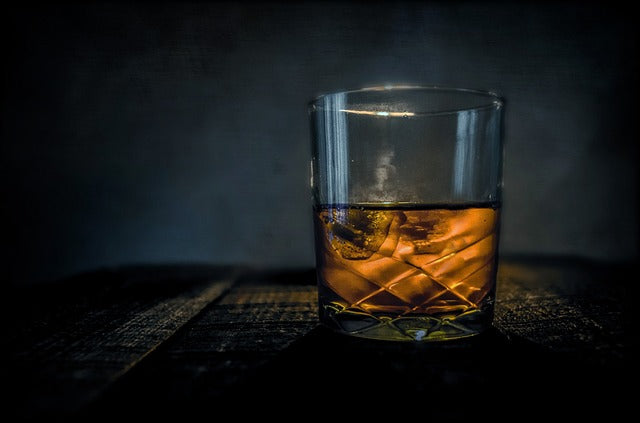Glossary of Whiskey & Bourbon Terms

ABV: An acronym for ‘Alcohol by Volume’, displayed as a percentage. Also called its ‘proof’.
Age/Age Statement: Sometimes used by distilleries to indicate how long the whiskey or bourbon has been aging.
Angle’s Share: This term is used to describe the amount of alcohol lost to evaporation and absorption by barrels (generally around 2% lost per batch). This name originated from a belief that the bourbon or whiskey evaporated to the heavens.
Barley: The primary malt grain used in the distillation of bourbon and whiskey.
Barrel/Cask: Often made from bound oak wood staves held together by metal hoops, these barrels/casks are used to store whiskey as it ages, imparting both aroma and flavors into the spirits.
Barrel/Cask Proof or Strength: Presuming no dilution has taken place, a spirit that is cask proof or barrel proof/strength is generally between 58-66% ABV.
Blend: Created by the combination of several whiskeys or bourbons. Referred to as ‘blended whiskey’.
Blender: The individual or team of individuals responsible for crafting the final blended product, which may include the blending of various whiskey and bourbons, and also neutral grain spirits, flavors, and colors.
Bottled-In-Bond: Bottled in accordance to the ‘Bottled-in-Bond’ Act of 1897 and exclusive to the USA. Requires that the whiskey be distilled by a single US distiller within one year, and followed by a 4-year aging process under government supervision in a federally bonded facility. The final requirement is that it be bottled at 50% alcohol (100 proof).
Bourbon: A distilled spirit aged in a charred oak barrel. Invented in the USA, a bourbon is required to have a mash consisting of at least 51% corn, in addition to a combination of rye and malt.
Char / Charring: Wood barrels used for aging are sometimes charred (partially burned) on the interior in order to impart smokey flavors and aromas to the whiskey or bourbon.
Chill Filtration: A cold filtration process used to reduce residues and eliminate cloudiness to improve aesthetic appeal.
Congener: Congeners are chemical byproducts created in by the process of distillation. Congeners include substances such as acetone, methanol, and tannins.
Cooper/Cooperage: A cooper is an individual whose profession involves making and/or repair of casks and barrels. A cooperage, refers to the facility that manufactures these barrels.
Corn: Native to North America, corn is a common plant used in the distillation of bourbon and whiskey.
Distillation: The process of purifying a liquid by heating and cooling. In the context of whiskey and bourbon, distillation is often used to broadly describe the entire process of manufacturing the spirit. From alcohol removal during fermentation from the wash, to maturation of the concentrated spirit before bottling.
Distiller/Distillery: A company or person who distills liquor.
Distiller’s Beer: A viscous fermented mash comprised of cooked grains, yeast, and water. Roughly 7-10% ABV, this mash fits the legal definition of beer and is drinkable.
Dram: A measurement of liquid by volume, totaling 1/8 fluidounces. A ‘dram’ is also loosely used to describe a small serving of spirits.
Ethanol: Volatile and colorless, ethanol is a flammable liquid alcohol made as a result of the fermentation process.
Expression: Sometimes used to describe alterations made to a whiskey recipe, such as altering the ingredients, aging, or distillation process. In other words, a variation on a given recipe that doesn’t deviate too far from the original.
Fermentation: In the context of whiskey and bourbon, the process by which yeast breaks down sugars to create ethanol.
Finger: A rough estimate of volume, aptly described as the amount of liquor it would take to fill a standard whiskey glass up to the width of a single human finger wrapped around the base. Comes out to roughly an ounce.
Finish: This term has two meanings. The first, is the ‘finishing’ notes (flavor) and aroma a spirit has after swallowing the drink. The second meaning refers to the secondary aging process of whiskey, such as moving from one aging barrel to another.
Foreshots/Feints: The first vapors that burn off during the process of distillation are called foreshots. These foreshots or feints typically contain dangerous chemicals such as methanol and other volatile alcohols.
Mash/Mash Bill: A mash bill is the recipe of grain ratios used to make a particular whiskey.
Master: A designation of honor, granted to industry-leading professionals such as master blender, master distiller, and others.
Nose/Nosing: Nosing a whiskey is simply the process of smelling or sniffing the whiskey. A spirit’s aroma or ‘nose’, can lend insight into its taste, finish, and profiles.
Oak: A preferred source of lumber used in the production of casks and barrels.
Oxidation: Oxidation is a process that beings once alcohol is exposed to ambient oxygen. The initial stages of oxidation are essential for bringing out all the flavors of a spirit. However, excessive oxidation over time can be detrimental to bourbon or whiskey.
Palate: The ability to discern nuanced aromas, flavors, and textures.
Peat/Peated: Peat is a moss native to boggy regions such as Scotland. Often added to whiskey recipes to impart smokey flavor and depth.
Proof: Measurement of alcohol content. Dividing by 2 will give you the percent ABV. For example, 80-proof is 40% ABV.
Rackhouse/Rickhouse: The warehouse/storage facility where whiskey/bourbon barrels are stored throughout the aging process.
Region: Geographic area where a whiskey or bourbon is made.
Rye: A grain in the barley and wheat family. Commonly used as an ingredient for making whiskey, bread, beer, and flour.
Scotch: A grain or malt whiskey made inside of Scotland, and following specific legal guidelines such as the use of malted barley and water, and a three-year minimum aging process resulting in a final product of 80 proof or higher.
Single Barrel: A premium limited-edition bourbon or whiskey bottled from a single spirit aged in a solitary cask or barrel.
Small Batch: A limited-edition whiskey or bourbon run with a finite number of casks or barrels.
Sour Mash/Sweet Mash: A combination of crushed grain meal or malt steeped in hot water. Sour mash is the predominant form of mash used in both Tennessee Whiskey and bourbon. Sour mash starts off with a bit of ‘left over’ mash from the previous run, whereas ‘sweet mash’ starts with fresh yeast for its fermentation process.
Spirit: A term commonly used to describe any distilled ‘hard liquor’.
Still: A still, or pot still, is a tank used to distill spirits, and is generally made out of copper or steel.
Straight: According to US law, a whiskey referred as ‘straight’ must be made from cereal grain mash not to exceed 80% ABV. Further, straight whiskey must be aged in charred oak barrels for a period no less than two years, resulting in an alcohol content not to exceed 62.5%.
Tun: A copper or stainless-steel vessel used to house the ingredients used for making a specific whiskey. This includes both dry and liquid ingredients (mash).
Unicorn: A term coined by whiskey and bourbon enthusiasts used to describe finding an exceptionally rare or difficult to find bottle.
Wheat/Wheated: One of the most common grains grown worldwide, wheat is occasionally used as a replacement for barley in beer, whiskey, and other spirits. Wheated spirits refer to those spirits that have had wheat added to the recipe (but not as a barley replacement). In this way, it is a flavor-adding addition.
Whiskey: Made from fermented grain mash, ‘Whiskey’ is a regional way to spell this spirit. Common in the USA thanks to Irish immigrants.
Whisky: The same thing as ‘Whiskey’, this regional spelling originates from Scotland and is commonly used to described fermented and distilled grain mash spirits in Canada, Scotland, Japan, and other regions of the world.
White Lightening: This is an old term used to describe bootleg moonshine, a clear, corn-distilled ‘grain alcohol’. Today, white lightening is sometimes used to describe ‘white whiskey’, a clear whiskey not aged in wooden barrels, high in alcohol content, and largely devoid of flavor.
Yeast: A microorganism that ‘eats’ and metabolizes sugars from grains, creating alcohol as a byproduct.
Recent Articles
- Best Cocktail Cherries for Elevating Your Home Bar [2025]
- How Are Cocktail Cherries Made?
- Things You Can Smoke With Aged & Charred Other Than Cocktails
- 12 Best Whiskies for an Old Fashioned
- 30 Popular Bourbons You Can Find Almost Anywhere
- What is Whiskey Made Of?
- The Science of Smoke: How Smoking Enhances Your Cocktails
- How to Pair the Right Wood Chips Your Smoked Cocktail
- How to Create a Home Bar Setup
- 10 Best Whiskeys to Stock Your Home Bar or Cart With

![Best Cocktail Cherries for Elevating Your Home Bar [2025]](http://www.agedandcharred.com/cdn/shop/articles/best_cocktail_cherries_fd4fa139-18d7-4d80-a09d-e90e03e183fb.jpg?v=1762540131&width=533)

